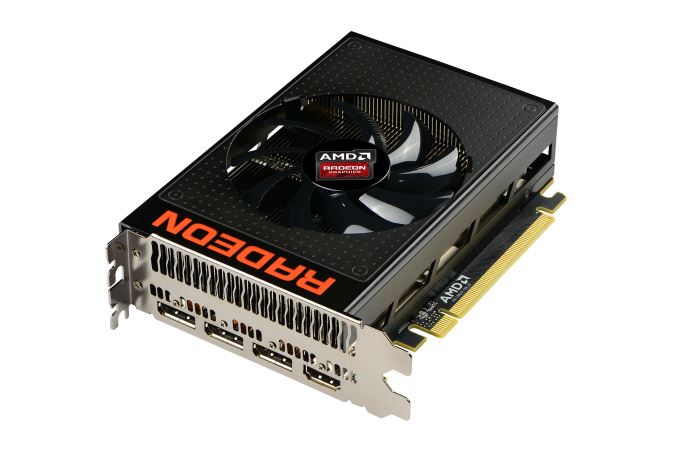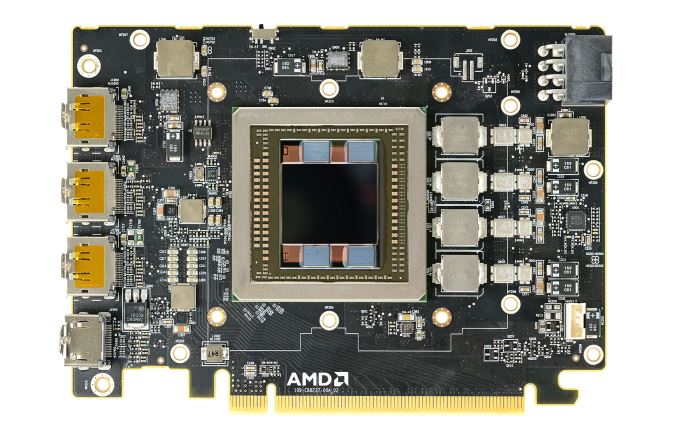The AMD Radeon R9 Nano Review: The Power of Size
by Ryan Smith on September 10, 2015 8:00 AM ESTFinal Words
Of all of the Fiji-based cards we’ve looked at so far, I feel like the Radeon R9 Nano is the most interesting of them. It’s not the fastest card or the cheapest card, but I like that AMD is trying unconventional things. A product like the R9 Nano will never be a high volume product, but it’s the kind of outside the box thinking AMD needs to do in order to better differentiate themselves from NVIDIA and to escape their increasingly damaging reputation as the value alternative underdog.
To that end there’s a lot to like about the R9 Nano, though it admittedly defies standard categorization at times. By all practical metrics this is a luxury card in the same vein as NVIDIA’s GTX Titan series, but at the same time it’s not a card built for chart-topping performance. Rather it’s a card built to push the envelope on power and space efficiency. This makes AMD’s job to sell the card to the public both harder and easier, though not always for obvious reasons.
Starting with the highlights then, let’s talk about the size. As far as Mini-ITX cards go the R9 Nano is a card without an equal. It is the fastest Mini-ITX card on the market and comfortably so, thanks to the fact that all other cards in this space are based on lower performing parts such as the GeForce GTX 970 and Radeon R9 380. Producing a small card is a solid, practical application of the Fiji package and the space savings of HBM, allowing AMD to produce a card just 6 inches (152mm) long. If you need the fastest thing that fits into 170mm or less – and you don’t mind paying top dollar for it – then the R9 Nano has earned its place right there.
Meanwhile when it comes to energy efficiency, the R9 Nano also marks a new high point for AMD. To cut right to the chase, AMD has struggled on the subject of energy efficiency for some time now, particularly since NVIDIA launched their Maxwell 1 and Maxwell 2 architectures last year. The release of the R9 Nano represents a significant improvement for AMD, showing us what an energy efficient implementation of Fiji is capable of.
Relative to the other Fiji cards – the Radeon R9 Fury series – AMD has been able to significantly cut their power consumption in exchange for a limited performance regression. At 2560x1440 – what I expect will be the gaming sweet spot for the R9 Nano – the card delivers 90% of the R9 Fury X’s performance and 96% of the R9 Fury’s performance. Though a tangible decrease in performance, it comes with 35% and 20% decrease in power consumption respectively, allowing AMD to offer better performance-per-watt than any other Radeon product to date.
Now there is a catch here, and that these efficiency improvements come from chip binning and a careful crafting of the product specifications, and not from an architectural improvement. On the whole Fiji still needs to draw quite a bit of power to achieve its peak performance and R9 Nano doesn’t change this. Instead with R9 Nano AMD makes a deliberate and smart trade-off to back off on GPU clockspeeds to save significant amounts of power. The last 100MHz of any chip is going to be the most expensive from a power standpoint, and as we’ve seen this is clearly the case for Fiji as well.
Otherwise on a broader competitive basis, while AMD is enjoying an improvement in energy efficiency they still must contend with NVIDIA, and here is where things get murky. Relative to the rest of their lineup the R9 Nano’s energy efficiency is fantastic. However relative to the energy efficiency of NVIDIA’s lineup, AMD’s gains mostly serve to close the gap that already existed. While admittedly only painting the broadest of strokes here, R9 Nano demonstrates slightly better performance than GTX 980 –around 5% at 2560x1440 – for a similar increase in power consumption. Which is to say that AMD has closed the gap, but they don’t have any real lead.
As a result the answer to the question “is there a market for energy efficient cards within the desktop space?” is going to hinge on price, and that puts AMD in a rough spot given the R9 Nano’s status as a luxury card. Clearly there’s a market for such cards – NVIDIA has spent the last year doing just that – but price is clearly a factor as well. Luxury products typically offer something that no other product offers, and while AMD’s energy efficiency has improved here, they aren’t offering a level of efficiency NVIDIA wasn’t already offering. And that as a result makes AMD’s task all the harder; they can’t pitch energy efficiency as a luxury element if NVIDIA already offers it.
In the end then the R9 Nano is a mixed bag for potential buyers. Its $650 price tag is without a doubt steep compared to the R9 Fury X and GTX 980 Ti, but in its niche of Mini-ITX cards it’s the card to beat, and that will give AMD the room they need to charge that price. On the other hand as great as R9 Nano’s power consumption and energy efficiency are, unless you also need the small size it doesn’t do enough to set itself apart from cheaper products like the GTX 980.
Finally, turning our eyes towards the future, there is one final Fiji product launch on AMD’s 2015 roadmap, and that is the unnamed dual Fiji card. By launching the R9 Nano first, AMD has primed the pump to potentially take their dual-GPU card in one of two different directions. They could essentially combine a pair of R9 Fury Xs and go for a maximum power, maximum performance card similar to the Radeon R9 295X2. On the other hand if they were to combine a pair of R9 Nanos they could produce a slightly slower but much more power efficient card. Both configurations have their virtues and weaknesses – energy efficiency versus absolute performance – so it should be interesting to see which of these two routes AMD takes later this year.












284 Comments
View All Comments
D. Lister - Friday, September 11, 2015 - link
It is interesting how the ratio of AMD fans on every tech website is about 50/50 with Nvidia fans, yet AMD's market share has dropped below 20%. What's up with that? Either a lot of you AMD guys aren't putting your money where your mouth is, or it's like the same 3 fanboys posting their stuff everywhere with multiple accounts. :pMathos - Friday, September 11, 2015 - link
Not really a fanboy of either side. I'm usually a fan of whatever will give me the best performance at the price point I can afford. Though currently I'm running an AMD HD7850 2GB, because thats what was best at below 200$ at the time I bought it.itproflorida - Friday, September 11, 2015 - link
coincidence I am replying to your post, but of course your not a fan but you will buy another amd card, good for you.Mathos - Friday, September 11, 2015 - link
Look I've probably been building and upgrading computer systems, longer than you've been alive there buddy, I've own more video cards than you'll probably ever know. Many of which predate both nVidia and ATI. I'm buying the R9 Fury, because at 550$, it's faster than similarly priced GTX 980's in the games that I have and play. Don't get me wrong, if I could afford more, I'd buy a 980ti. Unlike you, I apparently read bench marks and multiple reviews on such things. Plus I'm not one of these dumb people who buy x brand because they have the fastest top end card.... even though another brand has something faster at the price point I'm looking at.And speculation you say? Even though I've already been using said features with my 7850? Mostly just the frame rate limit settings to save power at the moment. Also.... have you not seen the performance difference with the DX 12vs11 benchmarks on other sites?
D. Lister - Friday, September 11, 2015 - link
@MathosI think there is a misunderstanding here - my statement was based on a general observation, not pointed at anyone in particular. You could attach a hamster wheel to your gpu slot and I wouldn't mind as long as you feed the hamster, not to mention it would work nearly just as well for Project Cars or Witcher 3 for less money. Sorry, couldn't resist. :D
Mathos - Saturday, September 12, 2015 - link
Oh no, wasn't replying to you, was responding to that Florida person on that harsh reply. As far as your's yeah I figured that. It was kind of ironic, that a fan boy came out to attack my choice on the other post though. I'll have to check out the project cars and witcher 3 bench's. Don't play many racing games, other than Grid and Dirt. I still haven't finished Witcher 1, not worried much about Witcher 3 for a while.Beany2013 - Sunday, October 4, 2015 - link
Anyone who publicly describes themselves as a 'pro', and subsequently can't even manage basic grammar and punctuation needn't be listened to. Simple as that.medi03 - Saturday, September 12, 2015 - link
That's because most of the uneducated public with little clue buys nVidia.HollyDOL - Saturday, September 12, 2015 - link
Funny enough, I started to buy nVidia after I become educated in 3D graphics. At that time ATI provided such a terrible developer experience I doubt I'd be able to forgive&forget yet in next few years.medi03 - Sunday, September 13, 2015 - link
nVidia outsold AMD even in Fermi times, with slower, more expensive, more power hungry chips.So, nope, sorry to bust your bubble.